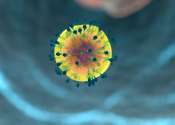How microbes hack into cells and why cancer drugs might block them
No matter the pathogen—virus, bacterium or fungus—many "pick a specific type of lock" on the surface of cells, which allows the microbe to break and enter into the inner sanctum of the host's genome.









